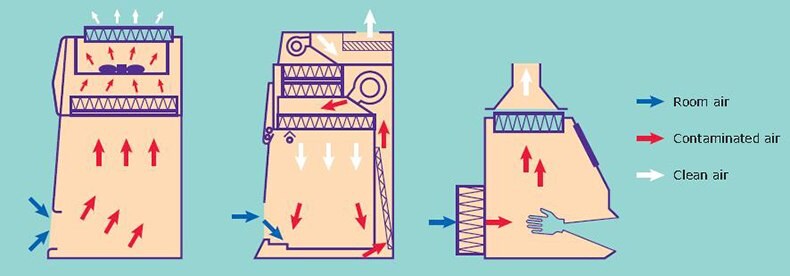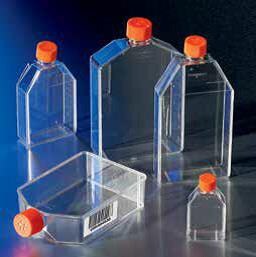Equipment for the Cell Culture Laboratory
ECACC Laboratory Handbook 4th Edition
Laboratory Design
Perhaps one of the most undervalued aspects of tissue culture is the need to design the facility to ensure that good quality material is produced in a safe and efficient manner. Most tissue culture is undertaken in laboratories that have been adapted for the purpose and in conditions that are not ideal. However, as long as a few basic guidelines are adopted this should not compromise the work.
There are several aspects to the design of good tissue culture facilities. Ideally work should be conducted in a single use facility which, if at all possible, should be separated into an area reserved for handling newly received material (quarantine area) and an area for material which is known to be free of contaminants (main tissue culture facility). If this is not possible work should be separated by time with all manipulations on clean material being completed prior to manipulations involving the ‘quarantine’ material. Separate incubators should also be designated. In addition, the work surfaces should be thoroughly cleaned and disinfected between activities.

All new material should be handled as ‘quarantine’ material until it has been shown to be free of contaminants such as bacteria, fungi and particularly mycoplasma. Conducting tissue culture in a shared facility requires considerable planning and it is essential that a good aseptic technique is used throughout to minimize the risk of contamination.
For most cell lines, the laboratory should be designated to at least BSL2/Category 2 based on the Advisory Committee on Dangerous Pathogens (ACDP) guidelines (ACDP, 1995)†. However, the precise category required is dependent upon the cell line and nature of the work proposed. The guidelines make recommendations regarding the laboratory environment including lighting, heating, the type of work surfaces and flooring and provision of handwashing facilities. In addition, it is recommended that laboratories should be run at air pressures that are negative to corridors to contain any risks within the laboratory. † (1995) Categorization of Biological Agents According to Hazard and Categories of Containment, 4th
Cell Culture Biosafety Cabinets
A biosafety cabinet, or laminar flow hood, is probably the most important piece of equipment for cell culture since, when operated correctly, it will provide a clean working environment for the product, whilst protecting the operator from aerosols. In these cabinets operator and/or product protection is provided using HEPA (high efficiency particulate air) filters. The level of containment provided varies according to the class of cabinet used. Cabinets may be ducted to atmosphere or re-circulated through a second HEPA filter before passing to atmosphere (Figure 1).
Environmental monitoring with Tryptone Soy Broth agar settle plates inside the cabinet for a minimum of four hours is a good indicator of how clean a cabinet is. There should be no growth of bacteria after incubation for 3 days, or of fungi after incubation for 5 days, on such plates.
In most cases a class 2 cabinet is adequate for cell culture. However, each study must be assessed for its hazard risk and it is possible that additional factors, such as a known virus infection or an uncertain provenance may require a higher level of containment.

Figure 1.
Cell Culture Incubators
Cell cultures require a strictly controlled environment in which to grow. Cell culture incubators are used routinely to provide the correct growth conditions, such as temperature, degree of humidity and CO2 levels, in a controlled and stable manner. Generally, they can be set to run at temperatures in the range of 28 °C (for insect cell lines) to 37 °C (for mammalian cell lines) and set to provide CO2 at the required level (e.g. 5-10%). Some incubators also have the facility to control the O2 levels. Copper-coated incubators are also now available. These are reported to reduce the risk of microbial contamination within the incubator due to the microbial inhibitory activity of copper. The inclusion of a bactericidal agent in the incubator water trays will also reduce the risk of bacterial and fungal growth. However, there is no substitute for regular cleaning and disinfection.

Work Surfaces and Flooring
In order to maintain a clean working environment, the laboratory surfaces including bench-tops, walls and flooring should be smooth and easy to clean. They should also be waterproof and resistant to a variety of chemicals (such as acids, alkalis, solvents and disinfectants). In areas used for the storage of materials in liquid nitrogen, the floors should be resistant to cracking if any liquid nitrogen is spilled. In addition, the floors and walls should be continuous with a coved skirting area to make cleaning easier and reduce the potential for dust to accumulate. Windows should be sealed. Work surfaces should be positioned at a comfortable working height.
Cell Culture Plasticware and Consumables
Almost every type of cell culture vessel, together with support consumables such as tubes and pipettes, are commercially available as single use, sterile packs. The use of such plasticware is more cost effective than recycling glassware, enables a higher level of quality assurance and removes the need for validation of cleaning and sterilization procedures. Plastic tissue culture flasks are usually either treated to provide a hydrophilic surface to facilitate attachment of anchorage dependent cells or untreated to provide a hydrophobic surface for the culture of cells in suspension.

| Cell Culture Flasks | HYPERFlask® | Stericup® Filters |
| Roller Bottles | Pipettes | Spinner Flasks |
| Cryogenic Vials | Multi-Well Plates | Culture Tubes |
| Cell Culture Plates | Centrifuge Tubes | Millex® Syringe Filters |
Care and Maintenance of Laboratory Areas
In order to maintain a clean and safe working environment, tidiness and cleanliness are key. All spills should be dealt with immediately. Routine cleaning should be undertaken involving the cleaning of all work surfaces both inside and outside of the microbiological safety cabinet, the floors and all other pieces of equipment (e.g. centrifuges) with 70% ethanol. Additionally, the elimination of potential mycoplasma contamination of cells and culture media must be achieved. Humidified incubators are a particular area for concern due to the potential for fungal and bacterial growth in the water trays. This will create a contamination risk that can only be avoided by regular cleaning of the incubator. All major pieces of equipment should be regularly maintained and serviced by qualified engineers, for example:
- Biosafety cabinets should be checked every six months to ensure that they are safe to use in terms of product and user protection. These tests confirm that the airflow is correct and that the HEPA filters are functioning properly.
- The temperature of an incubator should be regularly checked with a NAMAS (National Accreditation of Measurement and Sampling, UK), or equivalent calibrated thermometer, and temperature adjusted as necessary.
- Incubator CO2 and O2 levels should also be regularly checked to ensure the levels are being maintained correctly.
계속 읽으시려면 로그인하거나 계정을 생성하세요.
계정이 없으십니까?